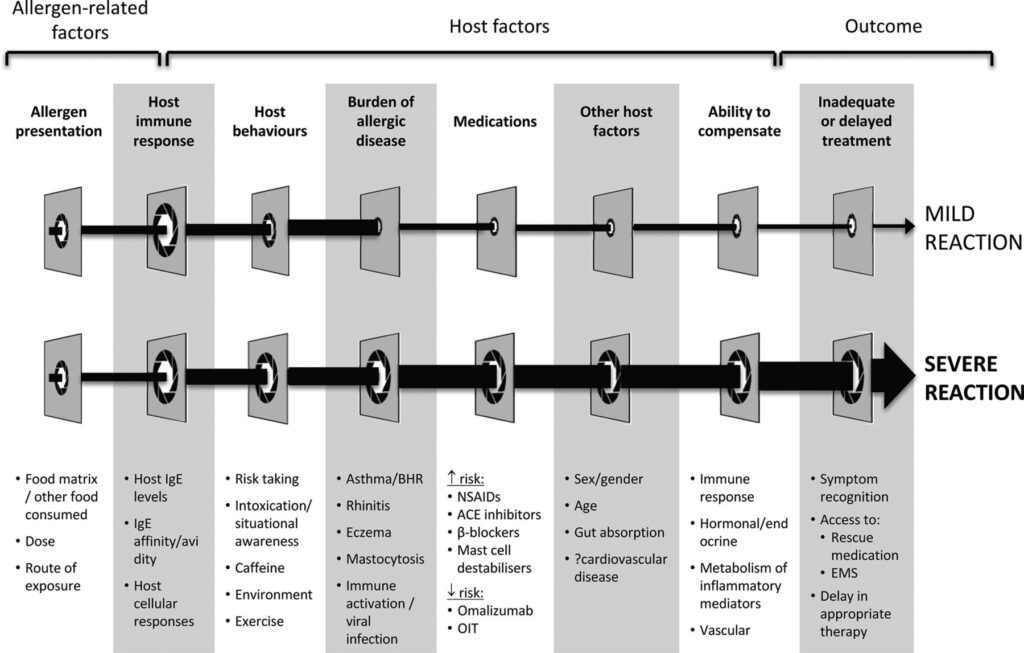Anaphylaxis, often abbreviated as A.S.A.R., is a life-threatening condition that requires immediate medical attention. It occurs when the immune system overreacts to an allergen, triggering a cascade of symptoms that can affect multiple systems in the body. Understanding its causes, recognizing its symptoms, and knowing how to respond during an emergency are critical for saving lives.

What Is Anaphylaxis?
Anaphylaxis is a severe allergic reaction that can happen within seconds or minutes after exposure to an allergen. Unlike mild allergies, which may cause localized symptoms such as itching or sneezing, anaphylaxis affects the entire body. This reaction can lead to difficulty breathing, a drop in blood pressure, and even loss of consciousness if not treated promptly.
How Common Is Anaphylaxis?
- An estimated one in fifty people will experience anaphylaxis at some point in their lives.
- Children and adults with known allergies are at higher risk.
- Certain populations, such as those with asthma or a family history of allergies, are more susceptible.
Common Causes of Anaphylaxis
Anaphylaxis can be triggered by a wide range of substances. Identifying these triggers is essential for prevention and management.
Food Allergens
Foods are among the most common causes of severe allergic reactions. The following foods are frequent culprits:
- Peanuts
- Tree nuts such as almonds, walnuts, and cashews
- Shellfish like shrimp, crab, and lobster
- Fish
- Milk
- Eggs
- Soy
- Wheat
Insect Stings
Bee and wasp stings are well-known triggers of anaphylaxis. People who have experienced a severe reaction to insect venom should carry an emergency treatment plan.
Medications
Certain medications can also cause severe allergic reactions. These include:
- Antibiotics like penicillin
- Nonsteroidal anti-inflammatory drugs such as aspirin and ibuprofen
- Chemotherapy drugs
- Vaccines in rare cases
Latec Products
Latec products, including latex gloves and balloons, can trigger anaphylaxis in individuals with latex sensitivity. Healthcare workers and patients undergoing frequent medical procedures are particularly at risk.
Exercise-Induced Anaphylaxis
In rare cases, physical activity can trigger anaphylaxis. This condition is known as exercise-induced anaphylaxis and may occur alone or in combination with food consumption before exercising.
Symptoms of Anaphylaxis
The symptoms of anaphylaxis can vary from person to person but often involve multiple systems in the body. Recognizing these signs early is crucial for timely intervention.
Skin Reactions
- Hives or welts
- Itching or flushing
- Swelling of the face, lips, tongue, or throat
Respiratory Symptoms
- Shortness of breath
- Wheezing
- Tightness in the chest
- Difficulty swallowing
Cardiovascular Symptoms
- Rapid or weak pulse
- Dizziness or lightheadedness
- Fainting
- A sudden drop in blood pressure
Gastrointestinal Symptoms
- Nausea or vomiting
- Diarrhea
- Abdominal pain
Other Symptoms
- A sense of impending doom
- Confusion or agitation
- Loss of consciousness
Emergency Care for Anaphylaxis
When someone experiences anaphylaxis, immediate action is necessary to prevent complications or death. Knowing how to respond can make all the difference.
Step 1: Administer Epinephrine
Epinephrine is the first-line treatment for anaphylaxis. It works by reversing the symptoms of the reaction. If the person has an epinephrine auto-injector, it should be used immediately.
- Inject the medication into the outer thigh muscle.
- Hold the injector in place for several seconds to ensure proper delivery.
- Call emergency services immediately after administering the injection.
Step 2: Call for Help
Even if symptoms improve after using epinephrine, professional medical care is still required. Call emergency services to ensure the individual receives further evaluation and treatment.
Step 3: Monitor Breathing and Circulation
If the person stops breathing or becomes unresponsive, begin cardiopulmonary resuscitation (CPR) until help arrives. Lay the person flat on their back and elevate their legs to improve blood flow.
Step 4: Avoid Additional Triggers
While waiting for emergency responders, remove any potential allergens from the area. For example, if the reaction was caused by a bee sting, carefully remove the stinger without squeezing it.
Preventing Anaphylaxis
Prevention is key to managing anaphylaxis. Individuals with known allergies should take proactive steps to reduce their risk of exposure.
Create an Allergy Action Plan
Work with a healthcare provider to develop a personalized allergy action plan. This plan should include:
- A list of known allergens
- Symptoms to watch for
- Instructions for using epinephrine
- Contact information for emergency services
Carry an Epinephrine Auto-Injector
Individuals at risk of anaphylaxis should always carry an epinephrine auto-injector. Ensure that family members, friends, and coworkers know how to use it in case of an emergency.
Wear Medical Alert Identification
Medical alert bracelets or necklaces can inform others of your allergies in case you are unable to communicate during a reaction.
Educate Others
Raise awareness about anaphylaxis among those around you. Schools, workplaces, and community organizations should be trained to recognize and respond to severe allergic reactions.
Living with Anaphylaxis
Managing anaphylaxis involves more than just avoiding triggers. It requires ongoing education, vigilance, and support from healthcare providers and loved ones.
Regular Check-Ups
Visit an allergist regularly to monitor your condition and update your treatment plan. New allergies can develop over time, so staying informed is essential.
Emotional Support
Living with the fear of anaphylaxis can be stressful. Seek support from counselors, support groups, or online communities to share experiences and coping strategies.
Stay Prepared
Keep your epinephrine auto-injector up to date and practice using it regularly. Familiarize yourself with the locations of nearby hospitals or clinics in case of emergencies.





